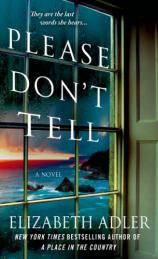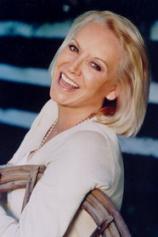Interview: July 11, 2013
Elizabeth Adler, the internationally bestselling author of over 25 novels, returns with her newest thriller, PLEASE DON’T TELL. When a blood-soaked stranger shows up on her doorstep one stormy night, Fen Dexter’s quiet life is not only interrupted, but potentially put in grave danger. In this interview with Bookreporter.com’s Amy Gwiazdowski, Adler talks about how important the settings of her novels are --- and how traveling is her favorite kind of research! She also tells Amy why “likable” characters make the best protagonists, which of the delicious recipes from her books are pulled from real life, the perfect number of dinner party guests, and all the books in her to-read pile.
Bookreporter.com: The California settings of PLEASE DON’T TELL --- Big Sur and San Francisco --- evoke strong images. The opening chapter, which features a massive storm beating the California cliffs, intimately introduces readers to the region and a bit of what’s to come. In fact, you treat both locations as if they were characters as well. Did you intentionally try to do this, or is it something that happened during the writing process?
Elizabeth Adler: The settings of Big Sur and Carmel, the strength and ruggedness, and the quiet calm little beach town were chosen because I know and love them, as well as for their contrast, great battering storms over the Big Sur rocks, and a tiny playful bit of beach at Carmel with its quaint shops --- almost like an English seaside town in a way. It appeals greatly to me.
BRC Your characters end up in some precarious situations. Do you find it difficult to write these scenes? For instance, after reading the first chapter, I’m absolutely sure I’ll never open my front door during a bad storm, no matter who is standing on the porch!
EA: I love writing about precarious situations. For instance, we all know we should never answer that knock at the door, especially on a stormy night, but Fen was expecting her granddaughter --- and my goodness, she got a bloodstained stranger instead. It gave me a lot of story to work on.
BRC: Dexter and her nieces, Vivi and JC, are strong, independent women who are very likable. They reminded me of people I know. Did you base these characters on people in your life?
EA: I’m much happier writing “likable” characters, real people with true emotions and complex thoughts. I hate to use the overworked phrase “people we can relate to,” but it’s important, I think, for the reader to be able to root for a character, to care about what happens to her. Otherwise, why bother?
Of course villains are always villains, and they get their own special treatment from me.
BRC: JC and Fen both have a love of fashion, willing to sacrifice comfort for style in a few situations. It becomes a big part of who the characters are as well. Do you ever find yourself in situations where fashion trumps comfort?
EA: Do I ever find myself in situations where fashion trumps? Yes. I will never, never, wear sneakers on a plane. Nor will I, though, wear heels. Still, I like fashion --- I’m the kind of shopper who never actually goes shopping for a specific item, but kind of flits through a store and spots something, buys it without trying it on (I hate those changing room mirrors), and therefore usually has to go back and exchange it. I love jeans, could not be without them. Love cashmere sweaters. In fact, add a t-shirt and that’s my daily uniform. But I do like to get dressed up a bit, too.
BRC: As a dog person, I adored Hector, a big, sloppy Lab, and the pink poodle named Flyin’ Fool. I liked that each played a special role in the story as well and weren’t just accessories for the characters. How did this come about? Do your own animals ever get written into stories?
EA: Our last dog was a massive, sloppy German shepherd by the name of CentyBoy. I adored him and he adored us. Now, though, we have two cats who are completely different. There’s SweetPea the Siamese who knows everything and lets us know she knows it --- she’s a great talker, especially when I’m on the phone. She also needs love and hugs and kisses and chatting to. In fact, she believes she is a person. Now Sunny, our big black yellow-eyed cat, was found at two weeks old abandoned on a street corner, and rescued by a caring group. We adopted him, and he is the smiliest, happy big guy ever; we adore him and he makes us laugh. Love our cats --- who now, I must say a bit worriedly, are both 10 years old.
BRC: Travel plays an important role in your life. Do memories or certain locations serve as inspiration?
EA: Travel has always played a part in my life. How many women do you know who eloped (from London) to Rio de Janeiro? And I have lived in Oxford, London, Vancouver, Dublin, Spain, France and, of course, California. I’m thinking of trying Florida next. (I probably missed a couple of countries above.) And, of course, travel is always a great inspiration...how can I not write about Paris, when I love it so? It’s my favorite city.
BRC: You mention on your website that you love food and cooking. Fen is a bit of a food connoisseur, and some of the descriptions are enough to send a reader to the kitchen. When you include recipes in your books, are they favorite dishes of yours, or recipes you hope to someday master in the kitchen?
EA: Love to cook, love to give dinner parties! There’s nothing better than eight or 10 around a table (more splits the conversation into separate groups --- eight means the conversation can flow, usually). And yes, I do sometimes include recipes. I mention, for instance, Fen’s Beef Daube in PLEASE DON’T TELL and, I believe, in A PLACE IN THE COUNTRY, the delicious cheese soufflés (so easy, they are not really real soufflés).
BRC: Research is part of the writing process. What kind of research do you enjoy the most and what don’t you look forward to?
EA: The best part of research is the travel. I mean, if you’re going to write about Paris or Bangkok, you simply must go back and check that it’s still the same as last time you were there! It’s a good excuse anyway. Also, I love history; my first book was set at the turn of the century in France --- it combined my two loves in one novel.
BRC: The creative process is different for every author. What’s your approach to creating likable, as well as unlikable, characters?
EA: The thought of needing to be “creative” makes me reach for another cup of coffee. For me, and perhaps others, too, the seed of an idea might simply be a word, a place, an overheard conversation, a sentence that springs fully formed into my head, making me wonder why I thought that. There quite simply is no explanation for creativity, it simply is. And you have it or you don’t. Which does not mean it is easy. The first rule of creative writing is to sit in front of your computer and stare at it, make something happen on it.
BRC: What books are in your to-be-read stack? With summer in full swing, is there a book you can’t wait to read by the pool or at the beach?
EA: Oh, now you have me! I confess I much prefer to read history, biography, autobiography and nonfiction, unless I come across something wonderful as, for instance, John Richardson’s THE SORCERER’S APPRENTICE (his memoirs of life with Picasso and Douglas Cooper). On my to-read stack are TWO TOWNS IN PROVENCE by M.F.K.Fisher, Kenneth Clark’s THE OTHER HALF, and my best reading --- because I love her book, re-reading actually --- will be Elizabeth Jane Howard (anything and everything. She is the most British of writers, and her biography is witty and selfless, in that she spares herself, and the reader, nothing. Which makes her a memorable woman. She was married to Kingsley Amis, but she writes better (in my opinion, of course). Also, THE SUITORS by Cécile David-Weill, BEAUTIFUL RUINS by Jess Walter, THE PARIS WIFE by Paula McLain, GONE GIRL by Gillian Flynn, RULES OF CIVILITY by Amor Towles, LIFE by Keith Richards and SNOBS by Julian Fellowes, as well as autobiographies (naughty!) by Christopher Plummer, Rupert Everett and the Duchess of Devonshire.
BRC: What are you working on now, and when might readers expect to see it?
EA: Well! You might ask! Only a couple of weeks ago, I finished writing a suspenseful murder mystery, with my usual romantic mind also involved. The title is LAST TO KNOW. I am now ready for a long lie down on a sunny beach somewhere to recuperate and get over being shut away by myself (with the cats and my thoughts) for long periods of time. Writing (didn’t anyone ever tell you?) is hard work.




